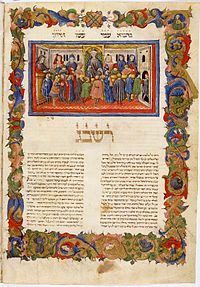Arba'ah Turim

| Part of a series on |
| Jews and Judaism |
|---|
Arba'ah Turim (
Meaning of the name
The title of the work in Hebrew means "four rows", in allusion to the jewels on the High Priest's breastplate. Each of the four divisions of the work is a "Tur", so a particular passage may be cited as "Tur Orach Chayim, siman 22", meaning "Orach Chayim division, chapter 22". This was later misunderstood as meaning "Tur, Orach Chayim, chapter 22" (to distinguish it from the corresponding passage in the Shulchan Aruch), so that "Tur" came to be used as the title of the whole work.[2]
Arrangement and contents

The Arba'ah Turim, as the name implies, consists of four divisions ("Turim"); these are further organised by topic and section (siman, pl. simanim).[3]
- The four Turim are as follows:
- Orach Chayim - laws of prayer and synagogue, Sabbath, holidays
- Yoreh De'ah - miscellaneous ritualistic laws, such as shechita and kashrut
- marriage, divorce
- Choshen Mishpat - laws of finance, financial responsibility, damages (personal and financial) and legal procedure
In the Arba'ah Turim, Rabbi Jacob traces the
Later developments
The best-known commentary on the Arba'ah Turim is the
The Tur continues to play an important role in Halakha.
- Joseph Caro's Shulchan Aruch, the fundamental work of Halakha, is a condensation of his Beit Yosef and follows the basic structure of the Arba'ah Turim, including its division into four sections and chapters - Tur's structure down to the siman is retained in the Shulchan Aruch.
- The views in the other commentaries are often relevant in ascertaining or explaining the Ashkenazi version of Jewish law, as codified by Moses Isserles in his Mappah.
Students of the Shulchan Aruch, particularly in Orthodox Semikhah programs, typically study the Tur and the Beit Yosef concurrently with the Shulchan Aruch itself: in some editions the two works are printed together, to allow comparison of corresponding simanim.
See also
- Mishneh Torah
- Shulchan Aruch
- Mishnah Berurah
- Shulchan Aruch HaRav
- Kitzur Shulchan Aruch
- Aruch HaShulchan
References
- ^ Adri K. Offenberg - The Printing History of the Constantinople Hebrew Incunable of 1493: A Mediterranean Voyage of Discovery, in The British Library Journal, Vol. 22, No 2 (Autumn 1996), Pp. 221-235. The specific mention of Southeast Europe & the Near East is on pg 223.
- Chumash".
- ^ The Shulchan Aruch contains a further division by paragraph (sa'if, pl. se'ifim), which is incorporated into some editions of the Arba'ah Turim to enable point-by-point comparison.
External links
- Arba'ah Turim, Prof. Eliezer Segal
- "Question 3.38: What is the Arba'ah Turim (The Tur, The Four Rows)?". faqs.org.
- Tur text in clear Hebrew print, TurShulchanArukh – AlHaTorah.org
